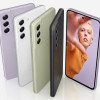Review: Sony Ericsson Vivaz
I really like the Vivaz's form factor. It is small, smooth, lightweight, and feels great in the hand. The entire back surface is a gently curved arc that makes it very comfortable. The width, thickness and length are all nearly perfect. It slips into a pocket with ease, and you'll almost forget it is there. On top of that, the fit, finish, and manufacture are all high quality.
There are just three buttons on the front of this touch phone, all crammed along the bottom edge. They are the send, home and end/back keys. The buttons are thin, and lined up in a mild smile. They protrude enough that they are easy to find, though both travel and feedback are a bit mushy.
Two ports are situated on the left side of the Vivaz. Tucked at the very tippy top is a 3.5mm headset jack. I wish the headset jack were on the top and not the side. Just below that is the microUSB port, which is covered by a rubber flap. The flap works fine and protects the port from dust.
Three buttons are placed on the right side of the Vivaz. The volume rocker is placed closest to the top. It is a string-thin strip that feels a little sharp to me, but it has good travel and feedback. Interestingly, Sony Ericsson has bestowed the Vivaz with separate keys to launch the video recorder and the camera. The video camera button is in the middle, and is slightly smaller than the camera button. It is a single stage key, and works well.
The dedicated camera key is larger, protrudes more, and has better travel and feedback. It is a two-stage key for taking photos, and each stage is distinct, which will help users focus shots before taking them.
I've always disliked that dedicated camera keys can launch both the camera and video camera, depending on how long you press the button. It's been a problem for me on more than one occasion when I wanted the camera and the video camera launched, and vice versa. Using two distinct keys solves that problem nicely.
The power/lock button is a slight dash notched in the top edge of the Vivaz. It is barely discernible from the surface of the phone, and has minimal travel and feedback. Given the importance of the lock key on touch phones, I would have preferred something a little larger.
In order to get at the microSD port, you need to remove the battery cover. Thankfully, the card is accessible without the need to remove the battery.












 Samsung Refines its Foldable Phones
Samsung Refines its Foldable Phones
 Samsung Revives S21 Fan Edition
Samsung Revives S21 Fan Edition
 Sony's New $1,600 Flagship Sports Seamless True Optical Zoom
Sony's New $1,600 Flagship Sports Seamless True Optical Zoom
 Motorola's new Edge Offers a Lot for $500
Motorola's new Edge Offers a Lot for $500
 Sony's Newest Compact, High-End Phone is the Xperia 5 IV
Sony's Newest Compact, High-End Phone is the Xperia 5 IV
 Sony Ericsson Vivaz
Sony Ericsson Vivaz


